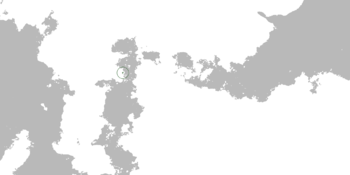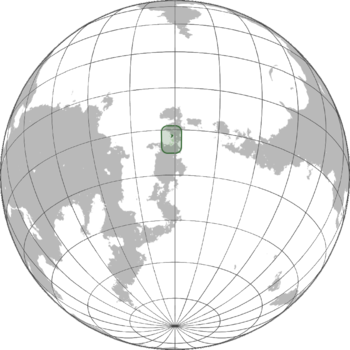Agios
Archdiocese of Agios Arcidiocesi di Agios | |
|---|---|
 Location of Agios. | |
 | |
| Capital and largest city | Agios |
| Official languages | Serrian, Edusan, Dolfik, Sedentrionale, Ithakan |
| Ethnic groups |
|
| Demonym(s) | Agiosian |
| Government | Unitary parliamentary constitutional monarchy |
| Legislature | Parliament of Agios |
| Area | |
• Total | 564 km2 (218 sq mi) |
| Population | |
• 2021 estimate | 3.7 million |
• 2020 census | 3,647,653 |
• Density | 6,458.3/km2 (16,726.9/sq mi) |
| GDP (nominal) | 2018 estimate |
• Total | $296 billion |
• Per capita | $80,000 |
The Archdiocese of Agios, more commonly referred to as Agios, is a Serrian overseas Archdiocese located on the island of Agios off the coast of Icaria in the Mauralin Gulf. Agios is well known for its very high standards of living, and unique hybrid Serrian-Icarian culture, which attracts millions of tourists a year from all over the world. Unlike Metropolitan Serria, Agios' older sections are in the Ithakan style and there are several ancient Icarian temples that are now used as Catholic churches.
Agios has a special relationship with the Icarian city of Altena, where they jointly fund public projects such as the South Island Nuclear Power Station, the public transportation network. Agios is connected to the mainland by one road/rail bridges, one road tunnel and two subway tunnels, and the South Island is connected to the main island by one road/rail bridge, and to the mainland by one road/rail bridge. Agios is a member of the Mauralin Renewable Energy and Powerlink Project with Paros, and Icaria.
History
Economy
At $296 billion and $80,000 per capita in 2018, Agios has one of the highest GDP per capita in the world with its GDP surpassing even small nations. The Agios CBD is the largest Serrian financial district in the region and is one of the largest in the world. Agios is a major trade hub in the region, with the port in the northern part of the city having the largest yearly throughput of any port in Icaria as of 2015. The economies of Agios and Paros are tightly intertwined with the Icarian economy, to the point where you could consider them to be one single economy rather than three separate ones. Many of Icarias largest companies have their Serrian branches located in Agios or Paros due to their proximity to the Principality.
Major Industries
The biggest industry in Agios is the financial sector(37%) with retail(22%), tourism(10%), IT(8%), consulting(7%), weapons systems(4%), education(4%), air and spacecraft manufacturing(3%), and shipbuilding(2%),making up the majority of the remainder. Major companies that operate in Agios include: Sapphire Aircraft and its subsidiary Sapphire Aerospace, Stefanidis Electronic Systems, Aardvark Aerospace, and the Bettino Armati Group.
Tourism
The Tourism industry makes up a significant percentage of the Agios Archdioceses GDP and there are commonly upwards of two and a half million visitors per year. Major attractions include the historic districts of the city which include several thousand year old temples and the Old Harbour built in 234 BCE which is still in use today by small boats and yachts.
Transport and Infrastructure
Agios has a well funded and developed public transportation network that it shares with its neighbour, Altena. The public transit network consists of an all electric bus system, a combined subway system that connects both cities together through two underwater tunnels, and one above ground high speed rail line that connects with the Icarian high speed rail network. There are three large bridges in Agios, the Long Agios Strait Bridge, Short Agios Strait Bridge, and the Marco Rossi bridge which connect Agios to the South Island and the mainland.
The Marco Rossi bridge is approximately 10km long and runs from the northernmost point of Agios to the northern part of Altena. Construction started in 1997, with the bridge being completed in 2005. The bridge features six road lanes and two rail lines that are used primarily for goods transport and trade between Serria and Icaria. The bridge construction is a mix of cable stayed for the majority of the length, and suspension for the longest span in the middle with a length of 1.3km at a height of 70m, allowing large ships to pass underneath.
The Agios Strait bridges are located on the southernmost point of Agios, and the southernmost point of the South Island, and connect the South Island to both Agios and the mainland. Construction started in 1963 and was completed in 1969. The bridges are a viaduct type, with the long bridge being approximately 10km long, and the short bridge being 7km long. Both have 25m of clearance beneath them, which prevents any large vessels from passing underneath. The bridges have four road lanes and two high speed rail lines in the middle of the bridge and are the main way to travel to the South Island from Agios or the mainland.
Geography
Agios Island
South Island
Demographics
Culture
Agios' culture has been heavily influenced by Serrian culture since the 1700s, forming a new unique hybrid culture that features heavy influence from both Icarian and Serrian cultures. Serrian Catholicism is the dominant religion, and many Serrian cultural norms have been introduced which have either replaced, or been fused with traditional Icarian norms. In the 1700s many prominent architects from Agios, Paros and Icaria worked with their counterparts in mainland Serria to develop a new architectural style, the Gulf style, that dominated these regions until the early 1800s. Many of these buildings still stand today in both the Archdioceses and mainland Icaria in the historic parts of their cities.
Religion
The official religion of Agios is Catholicism and as with the rest of Serria all schools teach the religion. Agios is 82% Catholic with a small minority of other religions and the nonreligious.